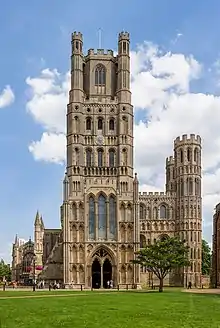Lands and Liberties of the Church at Ely
The Lands and Liberties of the Church at Ely was a 1080 court case and an appeal, where the Abbot of Ely sought recovery of lands that had been taken at the Conquest,[1][2] 14 years beforehand.

The liberty of Ely was established in (King) Edgar's charters for the refounded monastery in 970. Edward the Confessor reiterated the liberties in 1052 and then William the Conqueror restated them.[3]
Wherever the church of Ely had lands, it had its own courts where defendants in cases of theft could vouch to warranty. Severing of a hand and death were among the common penalties for significant theft.[4]
The court case can be viewed as a part of a large collection of pleadings against a process of Normanization that within a decade saw 64% of land in England consolidated into the hands of just 150 individuals, and many of the nobility and churches deprived of their estates.
References
- Liber Eliensis 251; Publisher: Anglican Christian Society p22.
- Bigelow, Melville Madison (1881). "Placita anglo-normannica:law cases from William I. to Richard I. preserved in historical records". Boston: 22. Cite journal requires
|journal=(help) - E. Miller, 'The Ely Land Pleas in the reign of William I', E.H.R. lxii (1947), 455.
- Trinity College. Camb. O. 2. 1, f. 115a.
